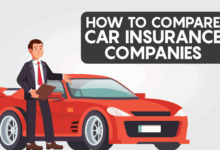Automobile Insurance: A Comprehensive Guide
Automobile insurance is a critical aspect of responsible vehicle ownership, offering financial protection against accidents, theft, and other unforeseen events. Understanding the various types of coverage, factors influencing premiums, and the claims process is crucial for making informed decisions and ensuring adequate protection. This guide delves into the intricacies of automobile insurance, providing a clear and comprehensive overview for both new and experienced drivers.
From liability coverage to collision and comprehensive options, we’ll explore the nuances of each type and how they contribute to your overall financial security. We’ll also examine the factors that determine your premium costs, such as driving history and location, and provide practical strategies for minimizing expenses. Ultimately, this guide aims to empower you to navigate the world of automobile insurance with confidence and make the best choices for your individual needs.
Types of Automobile Insurance
Choosing the right auto insurance is crucial for financial protection in case of accidents or unforeseen events. Understanding the different types of coverage available is the first step in securing adequate protection. This section details the common types of auto insurance, their benefits, drawbacks, and key features.
Liability Coverage
Liability insurance covers damages and injuries you cause to others in an accident. This is usually expressed as a three-number limit, such as 100/300/100, representing bodily injury liability per person ($100,000), bodily injury liability per accident ($300,000), and property damage liability ($100,000). Liability insurance is typically required by law, and its absence can lead to significant financial hardship. The benefits are clear: protection against lawsuits and substantial financial losses stemming from your fault in an accident. A drawback is that it doesn’t cover your own vehicle’s damage or medical expenses.
Collision Coverage
Collision coverage pays for repairs or replacement of your vehicle if it’s damaged in an accident, regardless of fault. This means even if you cause the accident, your insurer will help cover the costs. The benefit is peace of mind knowing your vehicle is protected, even in your own mistake. A drawback is the higher premium compared to other types of coverage. A deductible applies, meaning you pay a certain amount out-of-pocket before the insurance kicks in.
Comprehensive Coverage
Comprehensive coverage protects your vehicle against damage from non-collision events, such as theft, vandalism, fire, hail, or natural disasters. This is different from collision, which only covers accident-related damage. The benefit is broader protection against a wider range of risks. A drawback is that, like collision, it usually involves a deductible. The cost also varies depending on factors such as your vehicle’s value and location.
Uninsured/Underinsured Motorist Coverage
Uninsured/underinsured motorist (UM/UIM) coverage protects you if you’re involved in an accident with an uninsured or underinsured driver. This coverage pays for your medical bills and vehicle repairs, even if the other driver is at fault and lacks sufficient insurance. The benefit is crucial protection in a scenario where the other driver is unable to compensate you for your losses. A drawback is that it might not fully cover all damages, especially in cases involving serious injuries or extensive vehicle damage.
Medical Payments Coverage (Med-Pay)
Medical payments coverage (Med-Pay) helps pay for medical expenses for you and your passengers, regardless of fault. This coverage is helpful for minor injuries or when determining fault is difficult. The benefit is that it provides quick access to funds for medical treatment, simplifying the process after an accident. A drawback is that it often has a relatively low coverage limit and may not cover all medical expenses. It also doesn’t cover lost wages or pain and suffering.
Comparison of Auto Insurance Types
| Coverage Type | Coverage | Typical Cost | Benefits |
|---|---|---|---|
| Liability | Damages and injuries you cause to others | Varies widely; generally lower than collision/comprehensive | Protects against lawsuits and significant financial losses. |
| Collision | Damage to your vehicle in an accident, regardless of fault | Moderately high; varies with deductible and vehicle value. | Covers repairs or replacement of your vehicle after an accident. |
| Comprehensive | Damage to your vehicle from non-collision events | Moderately high; varies with deductible and vehicle value. | Protects against theft, vandalism, fire, and other non-accident events. |
| Uninsured/Underinsured Motorist | Damages caused by uninsured or underinsured drivers | Relatively low cost; often included with liability. | Protects you when the at-fault driver is uninsured or underinsured. |
Factors Affecting Insurance Premiums
Several key factors influence the cost of your automobile insurance premiums. Insurance companies analyze a range of data points to assess your risk profile and determine how much to charge for coverage. Understanding these factors can help you make informed decisions to potentially lower your premiums.
Insurance companies use sophisticated algorithms to calculate premiums, considering a multitude of variables. These variables are weighted differently depending on the insurer and the specific policy. While the exact formulas are proprietary, understanding the major components allows you to proactively manage your insurance costs.
Driving History
Your driving record significantly impacts your premiums. A clean driving record with no accidents or traffic violations will generally result in lower premiums. Conversely, accidents, especially those resulting in significant damage or injuries, and traffic violations like speeding tickets or DUIs, will substantially increase your premiums. The severity and frequency of incidents are crucial factors. For example, a single minor fender bender might result in a modest premium increase, while multiple accidents or a DUI could lead to significantly higher costs or even policy cancellation.
Age
Age is a strong predictor of driving risk. Younger drivers, particularly those under 25, are statistically more likely to be involved in accidents. Therefore, they often face higher premiums. As drivers age and gain experience, their premiums typically decrease, reflecting a lower perceived risk. This trend continues until a certain age, after which premiums may increase slightly due to factors such as declining eyesight or reflexes.
Location
Where you live plays a considerable role in determining your insurance rates. Insurance companies analyze accident rates, theft statistics, and the overall risk profile of different geographic areas. Areas with high crime rates or a high frequency of accidents generally have higher insurance premiums due to the increased likelihood of claims. Rural areas often have lower premiums compared to densely populated urban centers.
Vehicle Type
The type of vehicle you drive is another critical factor. Sports cars, luxury vehicles, and high-performance cars are generally more expensive to insure due to their higher repair costs and the greater potential for serious damage in accidents. Older vehicles, while often having lower premiums than newer models, may also incur higher premiums if they lack safety features or are considered more prone to mechanical failure. The vehicle’s safety rating, as determined by organizations like the IIHS, also impacts insurance costs.
Credit Score
In many states, your credit score is a factor in determining your insurance premiums. Insurers believe that a good credit score reflects responsible financial behavior, which may correlate with responsible driving habits. A higher credit score often translates to lower premiums, while a poor credit score can lead to significantly higher costs. It is important to note that this practice is controversial and varies by state.
Strategies for Lowering Insurance Premiums
Many actions can be taken to potentially reduce your insurance costs. These actions demonstrate your commitment to safe driving and responsible financial management.
- Maintain a clean driving record: Avoid accidents and traffic violations.
- Bundle your insurance: Combine auto and homeowners or renters insurance for potential discounts.
- Increase your deductible: A higher deductible means lower premiums, but you’ll pay more out-of-pocket in case of an accident.
- Shop around for insurance: Compare quotes from multiple insurers to find the best rates.
- Consider safety features: Cars with advanced safety features like anti-lock brakes and airbags often qualify for discounts.
- Take a defensive driving course: Completing a defensive driving course can demonstrate your commitment to safe driving and potentially earn you a discount.
- Maintain a good credit score: A good credit score can lead to lower insurance premiums in many states.
Filing a Claim
Filing an automobile insurance claim can seem daunting, but understanding the process can significantly ease the experience. A prompt and well-documented claim increases your chances of a fair and timely settlement. This section outlines the steps involved, from the initial accident report to receiving compensation.
Accident Reporting and Initial Information Gathering
Immediately after an accident, prioritize safety. If anyone is injured, call emergency services (911). Then, exchange information with the other driver(s) involved. This includes names, addresses, phone numbers, driver’s license numbers, insurance company information, and vehicle information (make, model, license plate number). Take photos of the damage to all vehicles involved, the accident scene (including road signs, traffic lights, and any visible skid marks), and any visible injuries. If there are witnesses, obtain their contact information as well. Note the date, time, and location of the accident precisely. This detailed documentation is crucial for your insurance claim.
Claim Submission
Contact your insurance company as soon as possible to report the accident. Most companies have 24/7 claims hotlines. Provide them with all the information you gathered at the scene. They will likely assign a claims adjuster who will guide you through the process. Be prepared to provide a detailed account of the accident from your perspective. Be honest and accurate in your statements. You may be asked to submit a completed accident report form.
Claim Processing and Investigation
The claims adjuster will investigate the accident. This may involve reviewing police reports, medical records (if injuries are involved), and witness statements. They will assess the damage to your vehicle and determine the liability. This stage can take several days or weeks depending on the complexity of the claim. You should be prepared to cooperate fully with the adjuster’s investigation and provide any requested documents promptly. This may include repair estimates, medical bills, and receipts for any related expenses.
Settlement and Compensation
Once the investigation is complete, the adjuster will determine the settlement amount. If liability is clear-cut, the process might be relatively straightforward. However, if liability is disputed, the process can take longer. The settlement may cover vehicle repairs, medical expenses, lost wages, and other related costs. You will likely receive a settlement offer from your insurance company. You have the right to negotiate this offer if you believe it’s inadequate. If you are dissatisfied with the offer, you may consider seeking legal advice. The final stage involves receiving your compensation, typically through a check or direct deposit.
Documentation Checklist
It is vital to maintain meticulous records throughout the claim process. The following checklist can serve as a guide:
- Police report (if applicable)
- Photos and videos of the accident scene and vehicle damage
- Contact information of all involved parties and witnesses
- Copies of driver’s licenses and insurance cards
- Medical records and bills (if injuries are involved)
- Repair estimates from certified mechanics
- Receipts for any expenses incurred due to the accident (e.g., towing, rental car)
- Your detailed written account of the accident
Understanding Insurance Policies
Your automobile insurance policy is a legally binding contract outlining the terms and conditions of your coverage. Understanding this document is crucial to ensure you’re adequately protected and aware of your rights and responsibilities. Failing to understand your policy can lead to unexpected costs and complications in the event of an accident or claim.
Understanding the terminology and clauses within your policy is key to avoiding future problems. Take the time to carefully read through each section, and don’t hesitate to contact your insurance provider if anything is unclear. This proactive approach can save you significant stress and financial burden down the line.
Policy Definitions
Common terms within an auto insurance policy can seem confusing at first glance. However, familiarizing yourself with these terms empowers you to make informed decisions about your coverage. The following table clarifies some key definitions.
| Term | Definition | Example | Importance |
|---|---|---|---|
| Liability Coverage | Covers bodily injury or property damage caused to others in an accident you’re at fault for. | If you cause an accident that injures another driver and damages their car, liability coverage would pay for their medical bills and vehicle repairs. | Protects you from potentially devastating financial consequences if you cause an accident. |
| Collision Coverage | Covers damage to your vehicle in an accident, regardless of fault. | If you hit a deer or are involved in a single-car accident, collision coverage will repair or replace your vehicle. | Essential for protecting your investment in your vehicle. |
| Comprehensive Coverage | Covers damage to your vehicle from non-collision events, such as theft, vandalism, or natural disasters. | If your car is stolen or damaged by a hailstorm, comprehensive coverage will help with repairs or replacement. | Provides broader protection against a wider range of risks. |
| Deductible | The amount you pay out-of-pocket before your insurance coverage kicks in. | A $500 deductible means you pay the first $500 of repair costs before your insurance pays the rest. | Lower deductibles mean lower out-of-pocket costs, but higher premiums. |
| Premium | The amount you pay regularly to maintain your insurance coverage. | Your monthly or annual payment to the insurance company. | The cost of your insurance protection. |
Reviewing Your Policy
Thoroughly reviewing your policy before signing is paramount. Don’t just skim the document; take the time to understand each section, including the exclusions and limitations of coverage. This careful review ensures that you are aware of your coverage limits, deductibles, and any specific conditions that may apply. If you have questions, contact your insurer for clarification before committing to the policy. A clear understanding of your policy protects your financial interests.
Choosing the Right Insurance Provider
Selecting the right auto insurance provider is crucial; it impacts your financial protection and overall experience in the event of an accident or claim. A thorough comparison of different providers is essential to ensure you find the best fit for your needs and budget. This involves considering several key factors beyond just the premium price.
Finding the right auto insurance provider requires careful consideration of several factors. The best provider for one person may not be the best for another, depending on individual circumstances and priorities. A balance between cost, coverage, and customer service is key.
Coverage Options Comparison
Different insurance providers offer varying levels and types of coverage. Some may offer comprehensive coverage including collision, liability, and uninsured/underinsured motorist protection, while others may focus on minimum state-required coverage. Direct comparison of policy details, including deductibles and coverage limits, is essential. For example, one provider might offer a lower premium for liability coverage but a higher premium for comprehensive coverage compared to another. Understanding these nuances is crucial to make an informed decision.
Customer Service Evaluation
A reliable insurance provider should offer responsive and helpful customer service. This includes easily accessible communication channels, such as phone, email, and online chat, with representatives who are knowledgeable and efficient in handling inquiries and claims. Consider the provider’s reputation for resolving customer issues fairly and promptly. A provider with consistently positive customer reviews often indicates a strong commitment to customer satisfaction.
Pricing Analysis and Comparison
Insurance premiums vary significantly among providers. Several factors influence pricing, including your driving history, location, vehicle type, and coverage choices. Obtaining quotes from multiple providers allows for direct comparison of pricing for similar coverage levels. Remember that the lowest premium isn’t always the best option; ensure the coverage adequately protects your needs before making a decision. For instance, a slightly higher premium for a policy with better coverage might be more worthwhile in the long run.
Tips for Selecting a Reliable Provider
Choosing a reputable insurance provider requires diligent research and due diligence. Look for providers with strong financial stability ratings, indicating their ability to pay claims. Check the provider’s licensing and regulatory compliance to ensure they operate legally and ethically. Consider recommendations from trusted sources, such as family, friends, or financial advisors. A provider with a long-standing history in the industry often suggests reliability and stability.
Importance of Customer Reviews and Quote Comparison
Reading customer reviews provides valuable insights into a provider’s performance and customer satisfaction levels. Websites like Yelp, Google Reviews, and independent insurance review sites offer a platform for consumers to share their experiences. Comparing quotes from multiple providers allows for a direct comparison of price and coverage. Don’t just focus on the lowest price; ensure the coverage offered meets your specific requirements. Comparing apples to apples (similar coverage levels) is essential for a fair evaluation.
Questions to Ask Potential Providers
Before selecting an insurance provider, it’s advisable to gather comprehensive information. Understanding the provider’s claims process, including timelines and required documentation, is crucial. Inquire about discounts and potential savings opportunities, such as safe driver discounts or bundling options. Clarify the policy’s terms and conditions, including exclusions and limitations. Ask about the provider’s financial stability rating and customer service availability. Confirm the provider’s licensing and regulatory compliance.
Insurance Coverage for Specific Situations
Auto insurance policies don’t just cover the everyday fender bender. They also offer protection against a range of less common, but potentially devastating, events. Understanding these specific coverage options is crucial to ensuring you have adequate protection for your vehicle and yourself. This section will explore several scenarios where specialized coverage proves invaluable.
Uninsured/Underinsured Motorist Coverage
This coverage protects you if you’re involved in an accident caused by a driver who lacks sufficient insurance or is uninsured altogether. It covers your medical bills, lost wages, and vehicle repair costs, even if the at-fault driver cannot compensate you fully. The amount of coverage you choose is crucial; it should reflect the potential costs associated with significant injuries or vehicle damage. For example, if you’re in a serious accident with an uninsured driver, your medical bills alone could easily exceed $100,000, highlighting the importance of selecting a substantial uninsured/underinsured motorist coverage limit.
Out-of-State/International Accident Coverage
Your standard auto insurance policy typically provides some level of coverage when you’re driving in other states. However, the specifics can vary. Some states have mandatory minimum insurance requirements that exceed those in your home state, potentially leaving you underinsured. International travel presents even more complexities. You might need to purchase supplemental insurance to ensure adequate coverage for accidents abroad. Consider purchasing an international driving permit and researching the specific insurance requirements of your destination before traveling. For instance, driving in Mexico requires specific insurance coverage that often exceeds standard US policies.
Natural Disaster and Unforeseen Event Coverage
Comprehensive auto insurance policies usually cover damage caused by natural disasters like hailstorms, floods, or wildfires. This coverage also frequently extends to events like theft, vandalism, and collisions with animals. However, the extent of coverage and specific exclusions vary between policies. It’s essential to review your policy carefully to understand what’s covered and what’s not. For example, a policy might cover damage from a hailstorm but exclude damage from a flood unless you’ve purchased separate flood insurance.
Examples of Beneficial Coverage
Several situations illustrate the value of specific coverage options. Imagine being involved in an accident with a hit-and-run driver. Uninsured/underinsured motorist coverage would be essential to cover your losses. Or consider a scenario where a tree falls on your car during a severe storm; comprehensive coverage would protect you from the repair or replacement costs. Finally, if you regularly travel internationally, having supplemental international auto insurance can safeguard you against potential financial burdens in the event of an accident in a foreign country.
Legal Aspects of Automobile Insurance
Automobile insurance isn’t just about protecting your vehicle; it’s a critical aspect of legal compliance and personal responsibility. Understanding the legal ramifications of car insurance is essential for every driver. Failure to comply with insurance regulations can lead to significant consequences, impacting both your finances and your driving privileges.
Legal Requirements for Automobile Insurance
Each jurisdiction has its own specific legal requirements regarding automobile insurance. These requirements typically mandate a minimum level of liability coverage, protecting others involved in accidents you cause. For example, in some states, minimum liability coverage might be $25,000 per person and $50,000 per accident for bodily injury, with additional coverage for property damage. Other states may have higher minimums. Some jurisdictions also require uninsured/underinsured motorist coverage, protecting you if you’re involved in an accident with an uninsured or underinsured driver. It’s crucial to check your state’s Department of Motor Vehicles (DMV) website or consult with an insurance professional to understand the specific legal requirements in your area.
Consequences of Driving Without Adequate Insurance
Driving without the legally required minimum insurance coverage can result in severe penalties. These penalties can include significant fines, license suspension or revocation, and even jail time, depending on the jurisdiction and the circumstances. Furthermore, if you’re involved in an accident without adequate insurance, you could be held personally liable for all damages and medical expenses incurred by others involved, potentially leading to financial ruin. Your vehicle may also be impounded until proof of insurance is provided.
Resolving Insurance Disputes Through Legal Channels
Disputes between insurance companies and policyholders are not uncommon. If you believe your insurance company has unfairly denied or underpaid a claim, you have several options for resolving the dispute. These options can include filing a formal complaint with your state’s insurance department, pursuing arbitration, or filing a lawsuit. Arbitration is a less formal and less expensive alternative to litigation, where a neutral third party reviews the evidence and renders a binding decision. Litigation, however, should be considered a last resort, as it can be costly and time-consuming. Legal representation is often advisable in such cases.
Role of an Insurance Adjuster in the Claims Process
An insurance adjuster plays a crucial role in the claims process. After an accident, the adjuster investigates the claim, gathering information from all involved parties, reviewing police reports, and assessing the extent of the damage. They determine the liability for the accident and calculate the amount of compensation to be paid. Adjusters work for the insurance company, so their primary responsibility is to protect the company’s interests. However, they are also responsible for fairly assessing the claim and ensuring that the policyholder receives the benefits they are entitled to under their policy. Effective communication and documentation are vital in navigating the claims process with an adjuster.
Last Point
Securing the right automobile insurance is a significant decision that directly impacts your financial well-being and peace of mind. By understanding the various coverage options, influencing factors on premiums, and the claims process, you can make informed choices to protect yourself and your vehicle. Remember to carefully review policies, compare providers, and ask questions to ensure you have the appropriate level of coverage tailored to your specific circumstances. Driving safely and proactively managing your insurance can significantly contribute to a more secure and financially responsible driving experience.




